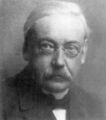Template:Selected anniversaries/August 17: Difference between revisions
No edit summary |
No edit summary |
||
| Line 9: | Line 9: | ||
File:Robert Fulton.jpg|link=Robert Fulton (nonfiction)|1807: [[Robert Fulton (nonfiction)|Robert Fulton]]'s North River Steamboat leaves New York City for Albany, New York, on the Hudson River, inaugurating the first commercial steamboat service in the world. | File:Robert Fulton.jpg|link=Robert Fulton (nonfiction)|1807: [[Robert Fulton (nonfiction)|Robert Fulton]]'s North River Steamboat leaves New York City for Albany, New York, on the Hudson River, inaugurating the first commercial steamboat service in the world. | ||
||1807: Johannes Nikolaus Tetens dies ... natural philosopher whose empirical approach strongly influenced the work of Immanuel Kant, and later in his life, Tetens became interested in mathematics, especially in actuarial applications. From 1760, as a teacher of natural philosophy he wrote on diverse topics but later began the development of the field of developmental psychology in Germany. He wrote Philosophische Versuche über die menschliche Natur und ihre Entwickelung (1777) on the origin and structure of knowledge. He changed career after 1789 to the civil service during which time he pursued mathematics. As a statistician he produced an Introduction to the Calculation of Life Annuities (1785) and On the Tetens Mortality Curve (1785). Pic. | |||
||1809: Matthew Boulton FRS dies ... manufacturer and business partner of Scottish engineer James Watt. In the final quarter of the 18th century, the partnership installed hundreds of Boulton & Watt steam engines, which were a great advance on the state of the art, making possible the mechanisation of factories and mills. Boulton applied modern techniques to the minting of coins, striking millions of pieces for Britain and other countries, and supplying the Royal Mint with up-to-date equipment. Pic. | ||1809: Matthew Boulton FRS dies ... manufacturer and business partner of Scottish engineer James Watt. In the final quarter of the 18th century, the partnership installed hundreds of Boulton & Watt steam engines, which were a great advance on the state of the art, making possible the mechanisation of factories and mills. Boulton applied modern techniques to the minting of coins, striking millions of pieces for Britain and other countries, and supplying the Royal Mint with up-to-date equipment. Pic. | ||
||1828: Jules Bernard Luys born ... neurologist and physician. | ||1828: Jules Bernard Luys born ... neurologist and physician. | ||
||1835: The wrench was patented by Solymon Merrick of Springfield, Massachusetts. | |||
||1862: American Indian Wars: The Dakota War of 1862 begins in Minnesota as Lakota warriors attack white settlements along the Minnesota River. | ||1862: American Indian Wars: The Dakota War of 1862 begins in Minnesota as Lakota warriors attack white settlements along the Minnesota River. | ||
||1877: Asaph Hall discovered the second of two moons Mars that he sighted this month. He named this second moon Phobos. Five days earlier, on 12 Aug 1877, Hall had observed the first moon, which he named Deimos. | |||
||1880: Paul Kammerer born ... biologist, he claimed to have produced experimental evidence that acquired traits could be inherited. Almost all of Kammerer's experiments involved forcing various amphibians to breed in environments that were radically different from their native habitat to demonstrate Lamarkian inheritance. (This is the idea that what one acquires during one's lifetime is passed on to that person's offspring. If you play guitar, your children will have nimble fingers. Each generation builds upon the past and continues to improve.) When later accused of faking exceptional results with the midwife toad, during a time of depression, he shot himself. Pic. | ||1880: Paul Kammerer born ... biologist, he claimed to have produced experimental evidence that acquired traits could be inherited. Almost all of Kammerer's experiments involved forcing various amphibians to breed in environments that were radically different from their native habitat to demonstrate Lamarkian inheritance. (This is the idea that what one acquires during one's lifetime is passed on to that person's offspring. If you play guitar, your children will have nimble fingers. Each generation builds upon the past and continues to improve.) When later accused of faking exceptional results with the midwife toad, during a time of depression, he shot himself. Pic. | ||
||1886: Alexander Mikhaylovich Butlerov dies ... chemist, one of the principal creators of the theory of chemical structure (1857–1861), the first to incorporate double bonds into structural formulas, the discoverer of hexamine (1859), the discoverer of formaldehyde (1859) and the discoverer of the formose reaction (1861). He first proposed the idea of possible tetrahedral arrangement of valence bonds in carbon compounds in 1862. Pic. | |||
||1891: The automobile electric self-starter was patented. | |||
||1893: Walter Noddack born ... chemist who discovered the element rhenium (Jun 1925) in collaboration with his wife Ida Tacke. In 1922, he began a long search for undiscovered elements. After three years, the careful fractionation of certain ores yielded element 75, a rare heavy metallic element that resembles manganese. Named rhenium after the Rhine River, it was the last stable element to be discovered. Noddack is also remembered for arguing for a concept he called allgegenwartskonzentration or, literally, omnipresent concentration. This idea, reminiscent of Greek philosopher Anaxagoras, assumed that every mineral actually contained every element. The reason they could not all be detected was they existed in too small quantities. Pic: https://sciencenotes.org/today-in-science-history-december-7-walter-noddack/ | ||1893: Walter Noddack born ... chemist who discovered the element rhenium (Jun 1925) in collaboration with his wife Ida Tacke. In 1922, he began a long search for undiscovered elements. After three years, the careful fractionation of certain ores yielded element 75, a rare heavy metallic element that resembles manganese. Named rhenium after the Rhine River, it was the last stable element to be discovered. Noddack is also remembered for arguing for a concept he called allgegenwartskonzentration or, literally, omnipresent concentration. This idea, reminiscent of Greek philosopher Anaxagoras, assumed that every mineral actually contained every element. The reason they could not all be detected was they existed in too small quantities. Pic: https://sciencenotes.org/today-in-science-history-december-7-walter-noddack/ | ||
| Line 55: | Line 65: | ||
||1958: Pioneer 0, America's first attempt at lunar orbit, is launched using the first Thor-Able rocket and fails. Notable as one of the first attempted launches beyond Earth orbit by any country. | ||1958: Pioneer 0, America's first attempt at lunar orbit, is launched using the first Thor-Able rocket and fails. Notable as one of the first attempted launches beyond Earth orbit by any country. | ||
||1958: John Marshall dies ... archaeologist who was director general of the Indian Archaeological Survey (1902-31). His aim was to bring to life Indian culture in the past by uncovering all possible details of her cities, tools, ornaments, laws and customs. In the 1920's, Marshall he began a systematic program of excavations that revealed Harappa and Mohenjo-daro, the two largest cities of the previously unknown Indus Valley Civilization, which he firmly believed was comparable in every way with the ancient civilizations of Egypt and Mesopotamia. He excavated Taxila, Vaisali, Nalanda, Rajagriha and Sarnath; enacted the Ancient Monuments Act (1904), built up a library, reorganised publications and recruited Indians to high positions in the Survey. Pic. | |||
||1966: Captain Henry Joseph Round dies ... engineer, one of the early pioneers of radio, and personal assistant to Guglielmo Marconi. He was the first to report observation of electroluminescence from a solid state diode. Pic. | ||1966: Captain Henry Joseph Round dies ... engineer, one of the early pioneers of radio, and personal assistant to Guglielmo Marconi. He was the first to report observation of electroluminescence from a solid state diode. Pic. | ||
| Line 68: | Line 80: | ||
||1977: The Soviet icebreaker Arktika becomes the first surface ship to reach the North Pole. | ||1977: The Soviet icebreaker Arktika becomes the first surface ship to reach the North Pole. | ||
||1978: | ||1978: The first crossing of the Atlantic Ocean by balloon was completed when three Americans, Ben Abruzzo, Maxie Anderson and Larry Newman, landed their Double Eagle II in France. Their 3,100-mile flight began on 11 Aug 1978 from Presque Isle, Maine and ended 137-hr 6-min later. The helium balloon Double Eagle II was 112- ft high, 65-ft diam., capacity 160,000 cu.ft. with a 15x7x4½-ft passenger gondola named The Spirit of Albuquerque. The underside of the gondola was a twin-hulled catamaran to provide emergency flotation for any unplanned water landing. Double Eagle II was built by Ed Yost. The history of transatlantic balloon crossing included seventeen prior unsuccessful attempts and seven lives lost. | ||
||1993: Feng Kang dies ... mathematician. | ||1993: Feng Kang dies ... mathematician. | ||
Revision as of 11:46, 15 August 2018
1807: Robert Fulton's North River Steamboat leaves New York City for Albany, New York, on the Hudson River, inaugurating the first commercial steamboat service in the world.
1904: Physicist, chemist, and crime-fighter Marie Curie condemns Extract of Radium as "a terrible hazard to health and sanity."
1927: Mathematician Erik Ivar Fredholm dies. He introduced and analyzed a class of integral equations now called Fredholm equations. Fredholm's work on integral equations and operator theory anticipated the theory of Hilbert spaces.
1929: Captain and pilot Francis Gary Powers born.
1930: Film director and arms dealer Egon Rhodomunde begins shooting his film Spy Pilot.
1970: Soviet spacecraft Venera 7 launched from Earth. It will become the first successful soft landing on another planet (Venus).
1996: Lorenz system develops self-awareness, spontaneous seeks out and fights crimes against mathematical constants.






